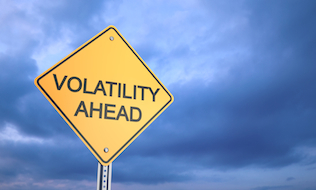
The majority of global institutional investors anticipate 2018 will be a year of increasing volatility in both the bond (70 per cent) and stock (78 per cent) markets, according to Natixis Investment Managers.
Its latest survey, which polled 500 institutional investors in North America, Latin America, Europe, Asia and the Middle East, found that 72 per cent of respondents are surprised volatility has been so low for so long. More than half (59 per cent) of respondents believe the absence of volatility is a major concern, while the same percentage believe flows into passive investment strategies have artificially suppressed fluctuation.
Read: Investors to consider alternatives amid increased volatility in 2017: survey
Nearly three-quarters (74 per cent) of respondents believe geopolitical events, such as tensions in North Korea and instability in the European Union, will negatively affect investment performance, followed by the impact of asset bubbles (65 per cent), rising interest rates (61 per cent), low yields (54 per cent) and the unwinding of quantitative easing (53 per cent).
“The predominant thing on institutions’ minds is geopolitics,” says Dave Goodsell, executive director of Natixis Investment Managers’ Center for Investor Insight. “It’s a politically uncertain world, nothing to date has triggered major market reactions, but I get the sense that they’re worried that something will happen. They can’t tell us what, but it will happen and that will drive markets into a greater volatile stance.”
The survey also found some institutional investors believe there’s a chance that a bubble is forming in the stock market (30 per cent), the bond market (42 per cent) and, especially, Bitcoin (64 per cent). The majority (74 per cent) of respondents believe individual investors are unaware of those possible bubbles. And 77 per cent of respondents worry that the prolonged period of very low interest rates is responsible for the potential bubbles.
“What’s interesting is, we’re not seeing them modify their return expectations in this,” says Goodsell. “The assumptions that most have are 7.2 per cent annual returns, and two-thirds are saying, ‘We’re not really going to change that, even though we see the potential for volatility and market change.’”
Further, 69 per cent believe stock correlations are likely to maintain current levels or move higher, and 76 per cent say alpha has been more difficult to come by. Just under half (46 per cent) think dispersion is likely to rise next year.
Read: Institutional investors exploiting risk for better returns, yields: survey
On the management side, the survey found 76 per cent of institutional investors believe the current environment will favour an active portfolio in the coming year, with 78 per cent of pension plans and 79 per cent of endowments and foundations in agreement.
According to institutional investors, the main advantages of an active strategy include the ability to provide improved access to opportunities in emerging markets (75 per cent), better exposure to non-correlated asset classes (74 per cent) and downside protection (73 per cent). Many also believe active management is the best way to generate risk-adjusted returns (69 per cent), take advantage of short-term market movements (69 per cent), ensure the integration of environmental, social, and governance factors (68 per cent) and generate stable income (58 per cent).
Anticipated allocations for the coming three years show investors are committing to a very active strategy, says Goodsell, noting that the anticipated rise in passive allocations found by the 2015 survey never materialized. In 2015, institutional investors were anticipating that passive allocations would rise to 43 per cent of their portfolios. This year, the survey’s respondents are expecting a rise to 33 per cent, just one per cent higher than where they are now.
While 75 per cent of the survey’s respondents say they’d be willing to pay higher fees for outperformance, 90 per cent believe passive investments are the best way to keep costs low.
Read: Why the investment industry needs to reconsider how it measures success
Respondents’ top three portfolio risk concerns for 2018 are interest rates (62 per cent), asset price volatility spikes (53 per cent) and liquidity (32 per cent). Some 64 per cent believe fixed income no longer provides its traditional risk management role in their portfolios.
On average, global institutional portfolios are currently allocating to stocks (37 per cent), bonds (34 per cent), alternatives (21 per cent) and cash (five per cent). More than 90 per cent are geographically diversified. In 2018, however, respondents intend to decrease exposure to U.S. stocks (36 per cent) and increase allocations to European equities (33 per cent) and emerging markets (27 per cent). They also plan to decrease exposure to high-yield bonds (33 per cent) and government debt (26 per cent) and increase allocations to emerging market debt (24 per cent).
Among all respondents, the biggest anticipated moves in the year ahead are increasing allocations to non-traditional assets, including private equity (39 per cent), private debt (36 per cent), real estate (33 per cent) and infrastructure (33 per cent). Of those currently invested in private equity, 81 per cent are happy with the performance. Nevertheless, 44 per cent say the lack of transparency discourages them from making investments in private equity.
Read: The challenge of maintaining fixed-income returns as interest rates rise
